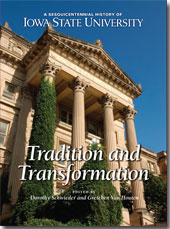New book chronicles life and times of Iowa State University
01-24-07
Contacts:
Tahira Hira, President's Office, (515) 294-2042, tkhira@iastate.edu
Carole Custer, University Marketing, (515) 294-3134, cacuste@iastate.edu
Annette Hacker, News Service, (515) 294-3720, annette@iastate.edu
New book chronicles life and times of Iowa State University

AMES, Iowa - In 1904, an Iowa State professor rolled through Iowa on a "Seed Corn Gospel Train," showing farmers how to select the best kernels for planting. Three years later, the Cyclones met the Nebraska Cornhuskers on the gridiron in Lincoln, in a game that both teams to this day claim as a win. And home economics majors of the 1940s got hands-on experience serving as surrogate mothers for infants who were wards of the state.
These stories and many more are part of a new history of Iowa State University. The just-released book offers a comprehensive, detail-rich look at the life and times of a university that will soon turn 150 years old.
"A Sesquicentennial History of Iowa State University: Tradition and Transformation" was commissioned as part of ISU's sesquicentennial celebration, which officially kicks off this spring during Veishea and continues through spring 2008. The new book is only the second full history of Iowa State ever published. The first, "The History of Iowa State College" by Earle Ross, was published in 1942.
The latest history surveys the early years of Iowa State and offers a longer look at the decades from 1940 through 2000. Eleven authors take readers on the 150-year journey that started with a small college on the prairie, separated from the city of Ames by three miles of pastures and fields.
Along the way, readers meet a succession of Iowa State presidents - people like Charles Friley, who led the campus through the world war years; James Hilton, who turned college into university and envisioned the complex that would become the Iowa State Center; and W. Robert Parks, who beefed up the humanities side of science-oriented Iowa State and guided an anxious community through the tumultuous Vietnam era.
Readers meet generations of students. They include cash-strapped Depression-era youth who formed cooperative dorms to save funds, couples who met on Coke dates and later got "pinned," and a hundred coeds who got their crack at the manly profession of engineering during the war years and acquitted themselves splendidly in the aircraft industry.
Readers also learn about the athletic men and women who wore cardinal and gold ... well, except for 1931, when former Michigan coach George Veenker outfitted his Cyclone football squad in a maize and blue reminiscent of the Ann Arbor team. The history book chronicles the achievements of the usual luminaries - like Gary Thompson, Troy Davis, Angie Welle, Nawal El Moutawakel, Cael Sanderson - and many lesser-known heroes. Freshman Tommy Neal's four touchdowns gave Iowa State a stunning rout of the Hawkeyes in 1934 and perhaps its longest-lived bragging rights to date. The rivals would not face each other on the football field again until 1977. Then there was Ron Gallimore, whose astonishing vault in 1981 earned him the first perfect 10 score in NCAA gymnastics history.
The 368-page history book contains more than 100 black and white photos. It was edited by Dorothy Schwieder, University Professor emerita of history at Iowa State, and Gretchen Van Houten, formerly with the Iowa State University Press.
A Sesquicentennial History of Iowa State University: Tradition and Transformation" can be purchased through the:
Iowa State University Book Store, available Feb. 1 (800) 478-0048 or (515) 294-5684
ISU Alumni Association, (877) ISU-ALUM or (515) 294-6525
Blackwell Publishing, (800) 862-6657
The book was published by Blackwell Publishing under the former Iowa State University Press imprint.
-------------------------------------------------------
Inside the book:
Home, Sweet QuonsetAfter World War II, servicemen, anxious to take advantage of the GI Bill, flooded campuses. Student enrollment at Iowa State skyrocketed from 3,407 in 1945 to 9,216 the following year. To help with housing needs, the university put trailers and military surplus Quonset huts in a neighborhood that would later become Pammel Court.
A tale of two Don SmithsTwo famous Don Smiths walked the Iowa State campus in the late '60s. Don Smith, the 6'8" Cyclone post player from Brooklyn , N.Y., was one of the first two Big Eight Conference basketball players to score more than 600 points in season twice. (Wilt Chamberlain was the other.) Later known as Zaid Abdul-Aziz, he went on to a 10-year career in the NBA.
Don Smith, the bearded activist, was elected president of the student body government in 1967 on a platform advocating total student freedom outside of class, legalization of marijuana and elimination of marriage. The mechanical engineering student attracted much attention from national news media and wrath from Iowa lawmakers who threatened to reduce university funding. He withdrew from office and Iowa State when some students began efforts to impeach him.
Lord, have mercyIn his last convocation speech, President James H. Hilton, after duly noting campus improvements and high enrollments, lamented the parking problem. "Lord have mercy on our souls!" he said. "What a problem this is! No matter how many additional parking spaces are provided each year they are filled and there is a clamor for more."
Cold War prankstersIn 1959, Soviet Premier Nikita Krushchev visited Iowa State as part of a national tour. As his motorcade rolled down Osborn Drive, four trench-coated students with fedoras, dark glasses and violin cases purposefully marched toward the Soviet leader's car. Security men quickly shoved the students back into the crowd. The incident was later characterized as a prank by "fun-loving college students."
-30-